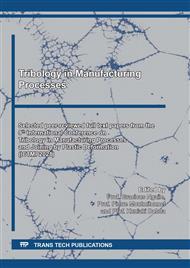p.45
p.51
p.59
p.69
p.75
p.81
p.89
p.95
p.103
Characterization of an Environmentally Friendly Tribological System for Deep Drawing Using Volatile Media as Lubricant Substitute
Abstract:
Commonly used lubricants in sheet metal forming usually base on mineral or synthetic oils, water based emulsions, drawing films or hotmelts (waxes). However, these conventional lubricants often contain harmful substances to human health and the environment. For this reason, a novel tribological system for dry metal forming has been developed. Basic principle of this new tribological system comprises the use of volatile media such as CO2 (liquid) and N2 (gaseous), which are injected into the contact interface under high pressure via injectors integrated into the tool. The volatile media used, lead to a significant reduction in friction and ensure robust friction behavior in deep-drawing processes. The investigations reported about in this contribution particularly focus on the friction behavior occurring in this tribological system at highly loaded radii. The friction investigations were carried out by using a modified stretch-bending-test and showed the effects of the main process-influencing parameters. In the present paper, these results are compared to already published results of the friction behavior investigated by means of flat strip drawing investigations. The findings obtained in this way allow a better understanding and prediction of the tribological system´s properties, thus making it usable for sheet metal forming applications.
Info:
Periodical:
Pages:
75-80
Citation:
Online since:
February 2022
Authors:
Keywords:
Price:
Сopyright:
© 2022 Trans Tech Publications Ltd. All Rights Reserved
Share:
Citation:


